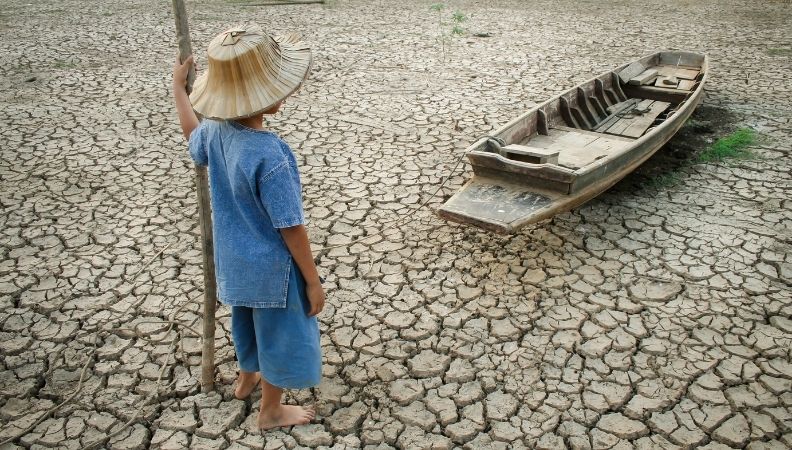The EARTH is Burning - What About our Climate?
Climate change - a much-used, meaning-loaden term
With the Earthshot Prize airing a few weeks ago and the COP26 UN Climate Summit well and truly underway, the effects of climate change are on many of our minds. That got us thinking about what we do here at NAYA to help tackle the climate crisis, and what we might be able to do more of.There are many other terms, such as climate change and climate variability. But what exactly is meant by this? It is about the worldwide change in the Earth's climate - through cooling or warming, the latter is currently happening. Both have existed for as long as the earth has existed and both pose great risks to humans and the environment, as the extent and consequences are very difficult to assess.
What is probably well known is that it is getting hotter and drier, the sea ice in the Arctic and the glaciers worldwide are melting, the oceans are warming up, becoming more acidic and the sea level is rising. And all of this has been happening even faster since this millennium than in the decades before.
And one thing is now also clear: we humans are responsible for a significant part of the rise in temperature. The Intergovernmental Panel on Climate Change (IPCC) recently confirmed this in its latest report on the current state of international climate research. This report scientifically substantiates the connections between extreme weather events and climate change.

WHO AND WHAT IS THE INTERGOVERNMENTAL PANEL ON CLIMATE CHANGE?
The Intergovernmental Panel on Climate Change (IPCC), based in Geneva, is a United Nations institution that regularly compiles the current state of knowledge on climate change and evaluates it from a scientific perspective. It presents different options for action without proposing concrete solutions and therefore sets the basis for science-based political decisions. Within the scientific community, the reports are regarded as the most credible and well-founded presentation of the state of scientific, technical and socio-economic research on the climate and its changes.
In mid-August 2021, the first part of a six-part report on the current climate situation was published, on which my statements in this article are also based.
FACTS ABOUT CLIMATE CHANGE
Let's start with the basics: What exactly is happening due to global warming, what does the report say about it and what does it mean for us?

1. THE WORLD IS GETTING WARMER
The Earth's temperature varies from year to year, that's clear, but it has risen enormously in the last 50 years. Sixteen of the 17 warmest years on record occurred after 2000, and the five warmest since 2010. Since 1977 - four decades now - there has not been a year on Earth cooler than the 20th century average.
In the current discussion, there is often talk of global warming of up to "1.5 degrees Celsius" or "well below 2 degrees". What exactly is meant by this? In the Paris Climate Agreement of 2015, 195 countries signed up to limit average global warming to the "1.5" or "well below 2 degrees" just mentioned. This refers to the warming from the time before industrialisation until today, i.e. before we humans caused increased emissions of greenhouse gases through production and progress. Currently, the global temperature has risen by about 1.1 degrees Celsius compared to the period between 1850 and 1900. The IPCC report sets out possible scenarios for the consequences of a rise in temperature. One very likely scenario shows that we will have reached the 1.5 degree Celsius increase already by 2030 instead of by mid-century as previously assumed. Depending on how emissions are reduced in the coming years, however, the researchers assume that we will have exceeded 1.5 degrees by 2040 at the latest. So the question is no longer whether we can still stop global warming by 1.5 degrees, but how long we can delay it and at what temperature we can keep it.
2. CLIMATE CHANGE IS MAN-MADE
According to the IPCC report, there is now no doubt about the human influence on global warming. By now it is clear to almost everyone: carbon dioxide is warming the planet. The global concentration of CO2 in the air has increased by almost 50% since the beginning of industrialisation, most of it since the 1960s.
Initially, of course, attempts are made to find a natural cause for the temperature rise, but none can explain the warming trend of the last 50 years. Solar radiation naturally fluctuates over time and volcanic eruptions can sometimes even cool a planet, according to climate researchers. Only CO2 and other greenhouse gases show a steady increase and ensure that less heat can escape from the planet. More than nine out of ten climate scientists are certain that our CO2 emissions are the main cause of global warming.
3. THE ICE IS MELTING RAPIDLY
Arctic sea ice, as well as glaciers worldwide, are melting. Since records began in 1850, the average area of sea ice in the Arctic has never been as low as it was between 2011 and 2020. The Arctic has warmed faster than the rest of the planet, and its ice cover has become smaller and thinner as a result. It's a vicious circle: as sunlight is absorbed by the dark sea instead of being reflected by the ice, global warming is further accelerated.
By 2100, sea levels could rise by 90 centimetres or more. However, the melting sea ice is not responsible for the sea rise, because it is already in the water. The ice on land, i.e. mountain glaciers, is the problem. Their melting is responsible for a rise in the seas, which has already caused devastating floods in coastal regions. Worldwide, 40 percent of humanity, about 2.8 billion people, live less than 100 km from a coast - by 2030, this could be 50 percent. For every centimetre of sea rise, up to one metre of coastal land is lost to the sea. That acute changes are underway here is also shown by the fact that at the highest point of the Greenland Ice Sheet, 3,216 metres above sea level, it rained in August this year for the first time since weather records began. Previously, precipitation was only measured here in the form of snow.

4. ACIDIFYING THE SEAS
To stay with the oceans: The oceans are gigantic carbon reservoirs and absorb considerable amounts of CO2 from the atmosphere. They already contain around 60 times as much carbon (38,000 gigatonnes) as the pre-industrial atmosphere. However, this constant exchange between the ocean and the atmosphere is happening too slowly, or we humans are emitting too much CO2 too quickly. The ocean is no longer able to absorb CO2 fast enough. In addition, the ability to store CO2 decreases with higher water temperatures and sinking pH values. Another vicious circle: the absorption of CO2 in the water forms a weak acid, which in its sum causes the pH value to drop. This is referred to as ocean acidification. Since the beginning of industrialisation, the acidity of the sea surface has increased by 30 percent. The change in pH also has consequences for marine life, because phytoplankton, the first link in the marine food chain, reproduces very slowly in acidic water. Calcification, which corals need, is also affected by ocean acidification.
5. THE WEATHER IS BECOMING MORE DESTRUCTIVE
Climate change is making storms and droughts more likely and more severe, especially in the case of heat waves. In fact, the Intergovernmental Panel on Climate Change has found that the number of extremes is increasing disproportionately as the Earth warms. Parts of the earth could therefore become uninhabitable by the end of the century - especially around the equator - and cause many people to lose their homes and have to flee.
An example from the report: heat events over land so severe that they occurred only once in 50 years in the 19th century are now about five times more frequent, i.e. every ten years on average. If the planet warms by 1.5 degrees by 2100, such an event would occur about every six years (8.6 times more likely), at 2 degrees somewhat more frequently than every four years (13.9 times more likely). And at 4 degrees warming, it would be almost 40 times more likely, meaning: extreme heat basically every year.
Global warming also removes moisture from the land and sea, which collects in the air and makes droughts more likely and more extreme. Precipitation in the form of rain or snow can be just as heavy, for example in July with the floods in NRW, Rhineland-Palatinate and Bavaria. According to the IPCC report, droughts will increase especially in the Mediterranean region and in western North America, but also in western and central Europe or in many parts of Africa. Only in northern Australia could droughts become less frequent. For many regions, however, there is insufficient data on this.
The report also deals with tropical cyclones, which, according to the researchers, have been observed more frequently in categories three to five in the past forty years and have changed their movement patterns, which cannot be explained by natural influences. Rather, the report explains that such cyclones, which occur during heavy rainfall events and most likely increase in intensity in this combination, can be attributed to human influence with a high degree of certainty.

6. ANIMALS AND PLANTS ARE AFFECTED
The climate is warming so fast that evolution cannot keep up. We are already seeing the disappearance of animal and plant species in ranges that are now too warm for them. Species extinction is the last step. And to stay with the melting sea ice: The retreat of the ice is driving walruses by the thousands towards the Alaskan mainland. Ocean warming, and in its wake ocean acidification, is also causing worldwide coral bleaching and reef death.
There will, of course, be adaptations: Humpback whales are taking advantage of the new ice-free waters of Antarctica and sea urchins are probably more resilient than thought - to name just two examples. Nevertheless, the question is how many species can adapt to the new circumstances and up to what maximum temperatures?
Researchers from the Intergovernmental Panel on Climate Change show that even if we humans reduce our emissions of greenhouse gases, we will only see a result much later, because many changes due to past and future greenhouse gas emissions cannot be reversed for centuries and thousands of years, especially changes in the oceans, ice sheets and global sea levels.
THE SCENARIOS OF THE IPCC REPORT
What exactly are the possible temperature trends? The report proposes different scenarios, which I would like to present to you briefly.
THE MOST FAVOURABLE AND DESIRED SCENARIO FOR US:
If we were able to radically reduce man-made greenhouse gas emissions as early as this decade, i.e. by the end of 2030, we could succeed in raising the global temperature by only about 1.5 degrees compared to the period between 1850 and 1900. This is what the Paris Climate Agreement envisages. According to the IPCC, only 500 billion tonnes of greenhouse gases would have to be blown into the air for this to be possible - at current emissions, this amount would already be reached in 13 years. Unfortunately, there is currently no indication that emissions could be reduced so quickly and significantly. Politicians would have to act here and present and implement a suitable, binding plan of action.
THE TWO PESSIMISTIC SCENARIOS:
The IPCC also shows extreme scenarios with amounts of CO2 in the air in which greenhouse gas emissions would triple or double for decades and continue to rise until the end of the century. In this case, global warming would increase to four to five degrees. Fortunately, however, climate researchers have dismissed these scenarios or classified them as unrealistic, since humanity would have to expand the burning of fossil fuels in unrealistic ways to achieve these extreme scenarios.
THE OPTIMISTIC SCENARIO:
In this scenario, global greenhouse gas emissions begin to steadily decline in this decade and reach zero in the 2070s. According to the IPCC, this would allow the two-degree target of the Paris climate agreement to be met. Mankind would only be allowed to release a good 1300 gigatonnes of greenhouse gas into the air, which would be reached after 34 years at today's levels.
THE REALISTIC SCENARIO:
The development that seems most realistic anticipates a further increase in greenhouse gas emissions by mid-century and a gradual decline around 2070. This would result in a warming of just under three degrees compared to the end of the 19th century, i.e. just under two degrees more than today.

7. CLIMATE IS A SHAREHOLDER IN EVERY DECISION
So how much temperatures rise depends on CO2 emissions. And it is clear: the sooner we act, the better. Admittedly, given the precarious state of facts and in view of the climatic consequences that global warming has already caused, a sense of hopelessness and helplessness often sets in. And honestly, these conditions often worry me too. But precisely because we now know the facts, we must act! The optimistic scenario is not unattainable and unchecked global warming caused by unregulated greenhouse gas emissions poses an enormous threat to health, prosperity and peace worldwide. We must force politicians to take climate change seriously and set the framework conditions needed to achieve this scenario, or at least the realistic one.














Leave a comment